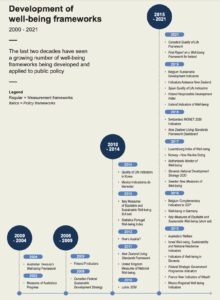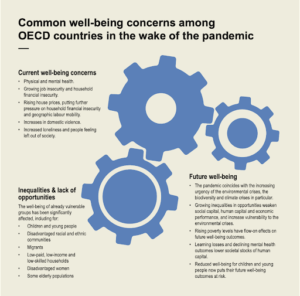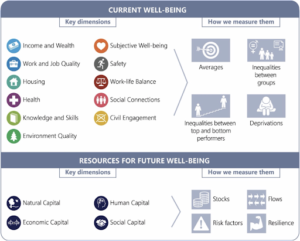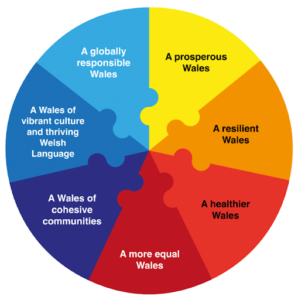Using a wellbeing approach to build forward
The OECD COVID-19 and Well-being report, released on 25 November 2021, describes how wellbeing evidence can guide a strong, inclusive and sustainable recovery by helping governments to refocus, redesign, realign and reconnect.
Refocusing policy actions on the outcomes that matter most
Over the past decade, many countries have developed national wellbeing frameworks to monitor current and future wellbeing, as well as inequalities. The evidence base that this has generated can now be leveraged to help focus and effectively target government action.
Figure 1: Growing development of well-being frameworks across OECD countries

Source: OECD (2021) COVID-19 and Wellbeing
Scanning the available evidence, the COVID-19 and Well-being report shows the wide-ranging impacts of the pandemic across people’s lives, affecting the economic, social, relational and environmental aspects of wellbeing, and both exacerbating and compounding inequalities. It highlights several common priorities for recovery among OECD countries (Figure 2).
Figure 2 Common well-being concerns among OECD countries in the wake of the pandemic

Source: OECD (2021) COVID-19 and Wellbeing
Redesigning policies and programmes by taking a multidimensional approach
The pandemic has also highlighted how closely interwoven economic, social, relational and environmental outcomes are. Wellbeing can provide the evidence base and a structured framework through which these links can be addressed in policy design – strengthening synergies across policy objectives and drawing out important trade-offs that need to be managed.
For instance, the report gives examples of several ‘triple win’ policy channels that can simultaneously raise current and future well-being while promoting opportunities for all:
- Encouraging green jobs that are inclusive and of high-quality.
- Investing in social infrastructure.
- Broadening the uptake of lifelong learning to those who need it most.
- Strengthening health promotion and prevention.
- Raising the well-being of disadvantaged children and young people
- Actively investing in reinforcing trust in others and in institutions
Figure 3 The OECD Well-being Framework: A multidimensional view on societal progress

Source: OECD (2020) How’s Life? 2020: Measuring Well-Being
Realign across policy departments and levels of government
Wellbeing frameworks can support governments to work collaboratively towards priorities, by shifting the focus from narrower outputs of individual departments towards shared outcome-based objectives. For example, the Welsh Wellbeing of Future Generations Act requires all Welsh public bodies to place seven wellbeing goals – informed by a large-scale public consultation process – at the centre of their decision-making (Figure 4).
Several governments have also started to integrate wellbeing frameworks into the government budget process and procurement strategies to forge collaboration and help drive stronger policy coherence. Importantly, these initiatives move beyond simply monitoring wellbeing to actively using wellbeing evidence and frameworks to inform policy priorities and decision-making across government.
Figure 4: Strengthening policy coherence through the Welsh Well-being of Future Generations Act

Source: Richard Owen (2020), www.theconversation.com/how-to-create-a-government-that-considers-future-generations-148947
Reconnect public, private and civil society stakeholders
Lastly, a wellbeing approach can help create stronger connections between public, private and civil society actors in building forward, based on a joint understanding of what societal wellbeing looks like. Wellbeing frameworks encourage open and transparent discussions about how to best manage the trade-offs and maximise the opportunities inherent in the frameworks, using a language that resonates with people.
In short, wellbeing frameworks can help governments to build back more resiliently by encouraging them to think and act more systematically, more collaboratively, and in more long-term and prevention-focused ways. As Minster Sarkkinen from Finland said at the launch of the report “People and the planet cannot wait”.
